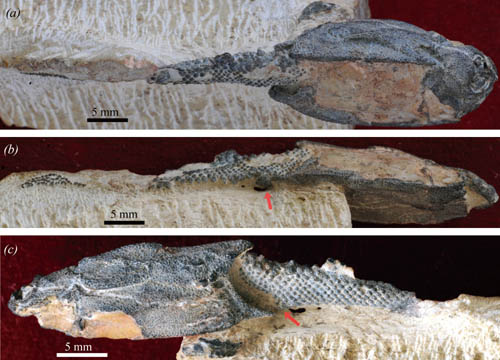New Study Showing Pelvic Girdles Arose Before the Origin of Movable Jaws
Almost all gnathostomes or jawed vertebrates (including osteichthyans, chondrichthyans, ‘acanthodians’ and most placoderms) possess paired pectoral and pelvic fins. To date, it has generally been believed that antiarch placoderms (extinct armoured jawed fishes from the Silurian–Devonian periods) lacked pelvic fins. As Parayunnanolepis xitunensis with extensive post-thoracic preservation represents the only example of a primitive antiarch, and its original description has been cited as confirming the primitive lack of pelvic fins in early antiarchs. Dr. ZHU Min, Institute of Vertebrate Paleontology and Paleoanthropology (IVPP), Chinese Academy of Sciences, and his research team reexamined Parayunnanolepis and offer the first unambiguous evidence for the presence of pelvic girdles in antiarchs, according to a paper published in journal of Biology Letters online 4 January 2012 in advance of the print. As antiarchs are placed at the base of the gnathostome radiation in several recent studies, this finding shows that all jawed vertebrates (including antiarch placoderms) primitively possess both pectoral and pelvic fins and that the pelvic fins did not arise within gnathostomes at a point subsequent to the origin of jaws.
Traditionally considered as placoderms, the antiarchs from the Silurian and Devonian periods are characterized by a distinct bony form with box-like thoracic exoskeleton and with elongate pectoral fins encased in interlocking dermal plates. Morphological features attributed to antiarchs and their interpretation play a pivotal role in recent analyses of early gnathostome interrelationships. In particular, the putative absence of pelvic fins has been considered (implicitly or explicitly) to be primitive (as in agnathans) rather than due to secondary loss within placoderms. Consequently, antiarchs are often regarded as a highly primitive clade, placed either in an unresolved trichotomy with all other jawed vertebrates (non-antiarch placoderms, chondrichthyans, ‘acanthodians’ and osteichthyans) and the jawless osteostracans, or as the sister-group to all other jawed vertebrates though crownward to the jawless osteostracans. It is also beleived that paired pelvic appendages (pelvic fins/hind limbs) appeared within the gnathostomes at a point subsequent to the development of movable jaws.
This pelvic girdle discovery shows that all jawed vertebrates (including antiarch placoderms) primitively possess both pectoral and pelvic appendages. While girdle-supported pectoral fins must have arisen before the origin of movable jaws, girdle-supported pelvic fins should no longer be inferred as having originated at a point subsequent to the origin of jaws. “Together with recent findings of paired appendages and girdles in other gnathostome groups, this discovery highlights the prevalence of parallel loss and/or reduction of pelvic fin and girdle components as a recurring phenomenon in the diversification of gnathostome groups, including placoderms”, explained ZHU Min, professor at the IVPP and lead author of the study.
“Parayunnanolepis xitunensis was unearthed from the Early Devonian (Xitun Formation, Lochkovian, about 413Million years ago) of Yunnan, China, and represents the only example of a primitive noneuantiarchan antiarch with extensive post-thoracic preservation. The original description, based in large part on the almost complete holotype (Institute of Vertebrate Paleontology and Paleoanthropology (IVPP) V11679.1), showed no trace of pelvic appendages in the figured and photographed material or in the reconstruction. This specimen has been subsequently cited as confirming the lack of pelvic fins in early antiarchs and thus in all antiarchs in general”, said WANG Junqing, emeritus professor at the IVPP and coauthor of the study, “As the post-thoracic anatomy of antiarchs is rarely preserved, the presence or the absence of pelvic fins in most antiarchs has been difficult to ascertain. Fortunately, in our reexamination of this specimen with additional preparation of the ventral surface, we observed the tiny paired pelvic girdles, confirming the unambiguous presence of pelvic fins.”
“The presence of pelvic girdles in the primitive antiarch Parayunnanolepis conclusively refutes the prevailing notion that all antiarchs lack pelvic appendages like jawless osteostracans. Viewed in this light, the absence of pelvic fins in derived antiarchs (e.g. Bothriolepis) can be best interpreted as secondary loss (as in some non-antiarch placoderms such as the petalichthyid Lunaspis), rather than as a retained primitive feature”, said Xiaobo Yu, professor of Biological Sciences at Kean University, New Jersey, and coauthor of the study, “Absence of pelvic fins can no longer be deemed as an unambiguous character supporting placoderm paraphyly.”
This research was supported by grants from the Chinese Academy of Sciences, the Major Basic Research Projects of MST of China, the National Nature Science Foundation of China, and the CAS/SAFEA International Partnership Programme for Creative Research Teams.

Fig.1. Parayunnanolepis xitunensis, a primitive antiarch with pelvic girdles from the Lower Devonian of China (IVPP V11679.1). (a) Dorsolateral view, (b) right ventrolateral view showing the dermal pelvic girdle immediately behind the trunk armour, and (c) left lateral view, (Images by ZHU Min)

Fig.2: Revised restoration of Parayunnanolepis xitunensis (Lochkovian, Early Devonian) in lateral (a), dorsal (b) and ventral (c) views. (d) Life reconstruction of P. xitunensis.(Images by Brian Choo)
Download attachments: